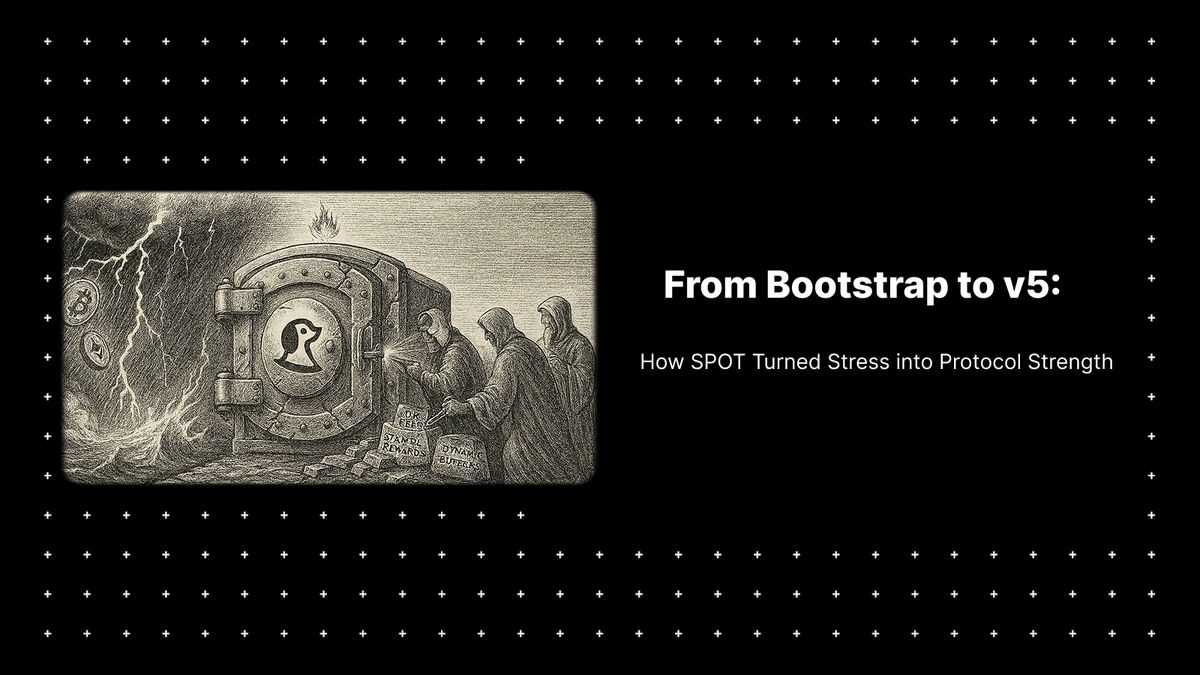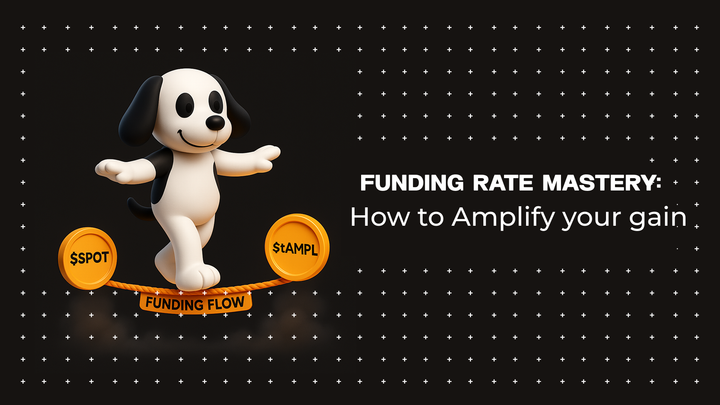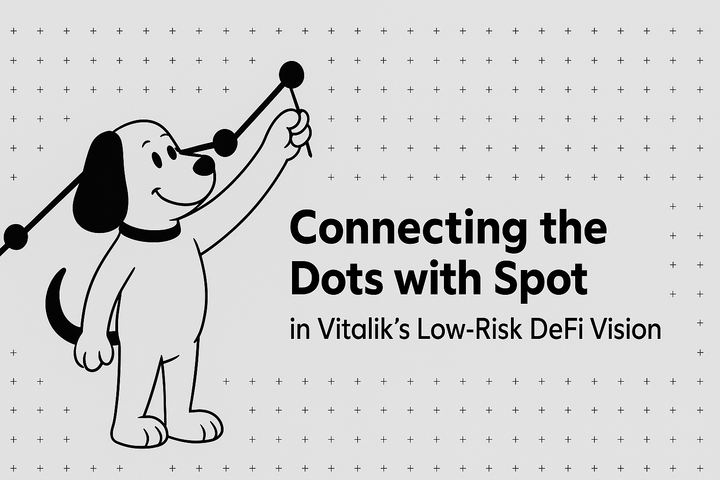From Bootstrap to v5: How SPOT Turned Stress into Protocol Strength

Introduction
2025 began full of anticipation for the Ampleforth community. Operation Bootstrap launched as a bold liquidity incentive program to accelerate SPOT adoption, ignite the Evergreen Cycle, and prepare the ground for USDaf (now AmpUSD). With $10M in AMPL rewards and early triple-digit APYs on SPOT/USDC LPs, expectations were sky-high.
But markets rarely cooperate. A global financial shock in Q1 derailed the plan. AMPL contracted sharply, vault risk spiked, and SPOT’s flywheel faltered just as it began to turn.
What looked like failure became formative. Operation Bootstrap served as a live-fire stress test, revealing how the system bends, how users behave under pressure, and what assumptions needed updating. Spot v5.0 emerged directly from that turbulence, not as a reaction in panic, but as a codification of hard-won insight.
Stress-Test in Action
Operation Bootstrap was designed to prove that tranching could deliver resilient, decentralized, peg-less stability on-chain. AMPL would flex, stAMPL would buffer, and SPOT would hold. Early behaviour aligned with that promise.
Then came the real test. A sudden macro shock in Q1 strained the system. But the structure held. In its wake came not retreat, but a deeper redesign. And from that emerged Spot v5.0: a principled refinement grounded in feedback from the protocol’s first high-pressure cycle.
The Q1 2025 Tariff Shock
The first signs of strain came as crypto markets tanked in Q1 2025—ETH dropped ~7% in a day, AMPL rebased sharply negative, and liquidity fled to stables. Then, in April, escalating tariffs triggered further flight from risk. The result was a series of vault-damaging rebases that impacted stAMPL holders just as liquidity incentives were supposed to ramp up.

While SPOT maintained stability, it shifted the burden to stAMPL holders, the risk sink of the system. They faced steep drawdowns with no immediate yield offset. And with minting fees still at 2.5%, arbitrage stalled just when it was most needed. Liquidity thinned, vault morale dropped, and some users misread short-term SPOT deviation as a signal of failure rather than healthy elasticity. As a result of these extreme market conditions, the Ampleforth team decided to discontinue Operation Bootstrap, as the AMPL rewards for SPOT x USDC liquidity could result in further downward pressure. What was envisioned as a flywheel for AMPL expansion turned into a risk for even further AMPL supply contraction.
What Went Wrong
Operation Bootstrap revealed several key pressure points:
- Minting friction: Arbitrage was delayed until price deviations were extreme, ironically increasing the vault’s rebase exposure.
- stAMPL drawdowns: The vault’s deviation ratio (DR) fell below 0.9 at times, halting minting entirely and compounding user losses.
- Bill Broker limitations: By design, Bill Broker only quotes when SPOT is far from FMV, leaving a gap in mid-range deviations that Uniswap had to fill.
- UX confusion: Many users interpreted deviation from 1.0 as SPOT “depegging,” rather than elastic adjustment around fair market value.
Operation Bootstrap exposed how the system must evolve when tested.
Governance Responds
The DAO quickly pushed forward multiple proposals: flash-mint fees were slashed from 2.5% to near-zero, DAO-held AMPL was temporarily injected into the stAMPL vault to stabilise the deviation ratio, and Bill Broker parameters were refined to concentrate liquidity around the peg. These weren’t minor tweaks; they were system-level responses informed by on-chain data and forum debate.
Spot v5.0: Codifying the Lessons
Spot v5.0 formalised live market lessons into protocol logic:
- Decoupling rotation/funding → fixes the enrichment failure when tranches didn’t roll.
- DR-based fees → solves the pro-cyclicality of minting when the vault is already strained.
- stAMPL earning all fees → aligns risk/reward for vault stakers who previously bore downside only.
- One-step minting → addresses user friction in building SPOT + stAMPL positions.
- Bill Broker upgrades → prevent it from sitting out mid-range moves by enabling negative fees.
Each upgrade addressed a limitation exposed during Bootstrap. The decoupling of enrichment from rotation fixed the stall-out that occurred when vault participation dropped. DR-based fees made the cost of user actions reflect their impact on system health. stAMPL now receives 100% of system fees, a direct response to the misaligned incentives that left stakers overexposed and underpaid. Pair minting reduced complexity for arbitrageurs. And Bill Broker’s new support for negative fees ensures it remains active even when inventory gets skewed, solving the liquidity gap that emerged during market shocks
Lessons & What Comes Next
Structural soundness alone isn't enough. Systems don't just need to work; they need to work with their users. Spot v5.0 confronts this head-on: acknowledging that protocol design must account for user psychology in addition to sound economic logic.
During the Q1 crash, the protocol behaved as expected, yet the people inside it didn’t. Vault users began withdrawing just as the system most needed their participation. In forum and discord discussions, that behavioral reflex became a central lesson: users need to be rewarded for staying through volatility, not just after it passes.
At one point, the vault's deviation ratio dropped so low that flash minting was suspended, freezing SPOT supply expansion precisely when arbitrage was most critical. It wasn’t a failure of the core mechanics, but of confidence, clarity, and coordination.
Spot v5.0 responds directly. stAMPL, once the silent shock absorber, now receives 100% of protocol fees, rewarding its role at the heart of the system. Minting and funding have been decoupled, smoothing reactivity. User flows have been simplified. And the DAO scaled back AMPL emissions, replacing them with a targeted FORTH geyser for stAMPL — a pivot away from short-term liquidity theatrics toward long-term vault sustainability.
These are more than patches. They’re durable upgrades, driven by live-fire protocol experience.
Conclusion: From Panic to Protocol Maturity
Operation Bootstrap didn’t collapse; it revealed the system’s true contours. It brought buried assumptions to the surface, exposed edge cases, and compelled the DAO to respond with concrete action.
Spot v5.0 emerged from that process, shaped by lived experience. It’s built to absorb volatility, internalize the lessons from stress, and translate them into protocol logic.
This is protocol maturity: peg-less, adaptive, transparent. A system that meets volatility head-on and evolves in stride.
Bootstrap didn’t deliver the clean ramp many hoped for, but it delivered something better: a blueprint forged in reality. With Spot v5.0, Ampleforth is no longer just proposing a new financial primitive. It’s operating one—in-public, under pressure, and with each upgrade, becoming more resilient.




